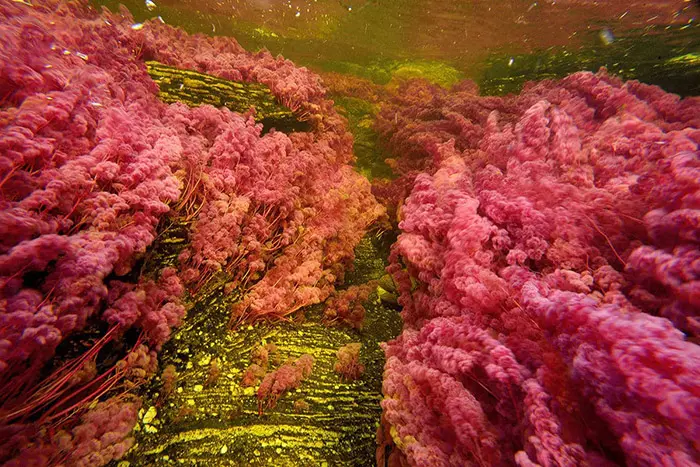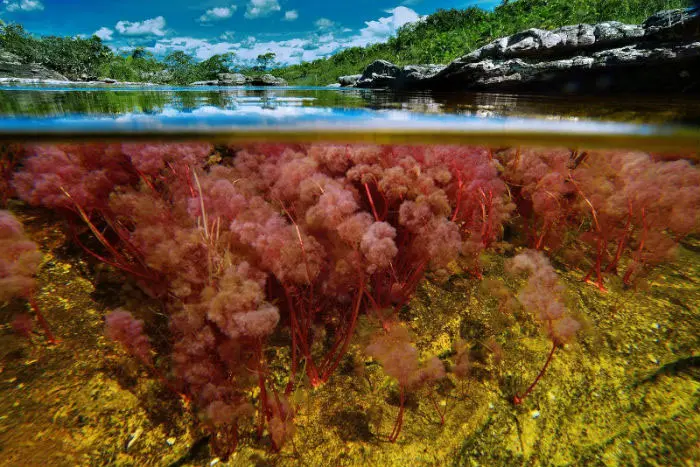The Cano Cristales River, often referred to as the “Rainbow River,” captivates visitors with its extraordinary and vibrant colors, harmoniously blending with the majestic surrounding landscapes to create a magnet for travelers from around the globe.

Where Is Cano Cristales Located?
Cano Cristales is situated in Serranía de la Macarena National Park, part of the La Macarena National Reserve in Colombia, covering an area of 3,900 square kilometers.
A tributary of the Guayabero River, it stretches about 100 kilometers long. For a few months each year, the river displays an astonishing array of colors, including red, yellow, green, blue, and black, crafting a magical and rare sight in the heart of South America.
Not only is this a famous tourist attraction in Colombia, but it is also considered a unique natural wonder, a gift from nature to the people of this land. During the transition between seasons, the river’s waters shimmer with dazzling, captivating hues.

Discovering the River’s Name
In 1980, upon first exploring this natural marvel, adventurer Andres Hurtado named the river “Cano Cristales.” Structurally, the river features fast currents, waterfalls, rocky cavities, and crystal-clear water that allows visitors to see straight to the bottom.
Covered by a variety of colorful algae, Cano Cristales is also called “The Rainbow River,” “The Five-Colored River,” or “The River from Heaven.” Its vibrant hues are thanks to a unique aquatic plant called Macarenia Clavigera, endemic to the Sierra de La Macarena mountains, located south of Bogotá, Colombia’s capital.

This aquatic plant transforms the river into a spectrum of colors, from green to bright red, orange, yellow, and even dark brown. These striking colors are further accentuated by the golden riverbed, lush green moss, translucent water, and the dark shades of rocky cavities, creating a stunning natural painting that leaves visitors amazed at nature’s wonders.
When Does Cano Cristales Change Colors?
Cano Cristales, along with Cocora Valley and Colombia’s giant rock El Peñón de Guatapé, ranks among the top tourist attractions in this South American country. However, unlike the other destinations, the unique color-shifting phenomenon of Cano Cristales only occurs during specific times of the year—at the seasonal transition.

During the rainy season, the river’s fast and deep waters prevent the Macarenia Clavigera from absorbing sunlight, a necessary condition for the plant to change into shades of red, green, yellow, brown, and orange.
According to many travelers’ experiences, the best time to visit Cano Cristales is between July and November, during the transition from the rainy season to the dry season. During this period, algae, aquatic plants, and corals—particularly Macarenia Clavigera—shift into various hues based on the river’s specific areas. Algae cling to rocks along the nearly 100-kilometer-long river, creating an extraordinary natural spectacle.

Standing at Cano Cristales during this time, one feels as though witnessing a vibrant, colorful tapestry crafted by nature itself, just beneath the river’s surface.
A Vibrant Natural Masterpiece
When the river transforms, the surrounding scenery is adorned with a vivid, radiant glow that lights up the landscape. Within moments, Cano Cristales evolves into a kaleidoscope of bright and bold colors, thanks to the marine algae. All these elements come together to create a harmonious painting of nature that fascinates visiting tourists.

One can easily notice the river’s segments showcasing distinct color transitions—sometimes it appears blue like seawater, at other times green, or even mossy green. At moments, it turns bright red from algae, resembling a giant ribbon cutting through the lush forests, forming a picturesque scene.
At other times, the river turns golden like the sand below, then shifts to dark brown amid rocky plates. Regardless of its colors, this remarkable river always blends perfectly with its surrounding environment, mirroring the sky, water, forests, or the rocky terrain above it.

During a short window of time, between the rainy and dry seasons, the river stabilizes, allowing the Macarenia Clavigera algae to bloom vividly. This aquatic species determines the intensity of the river’s colors, which depend on water levels and the amount of sunlight it absorbs. Simply put, the colors of Macarenia Clavigera are the colors of Cano Cristales.
Why Cano Cristales Is Called “The River from Heaven”
Due to its unique features, Cano Cristales has earned names like “The Rainbow River” or “The Five-Colored River.” Its unparalleled beauty and serenity also lead many to call it “The River from Heaven.”

If you visit during the rainy season, rest assured, as the river remains a sight to behold. During this time, the river is at its deepest and fastest flow, making it difficult for the Macarenia Clavigera to absorb sunlight, which causes the plant to turn fiery red, adding to the river’s mesmerizing charm.
Even without its color-changing phenomenon, Cano Cristales is a captivating destination due to its fast currents, crystal-clear waters, and the ability to see the riverbed. Visitors can also explore its stunning waterfalls, rocky cavities, and majestic landscapes, offering a romantic and adventurous experience.

The Remote Location of Cano Cristales
Located in a remote and pristine area, Cano Cristales remains untouched by urbanization. This 20-meter-wide and 100-kilometer-long river is nearly isolated from the outside world. In the past, the region surrounding the Rainbow River was closed to visitors for various reasons. It wasn’t until 2009 that travelers from around the globe were allowed to witness its unique beauty.
Since its opening, many tourists have chosen Colombia tours, frequently visiting the Rainbow River—not only to witness its color-shifting phenomenon but also to admire the natural beauty of the surrounding area. Each year, millions of visitors check in and spend days exploring Cano Cristales’ wonders.

Important Note for Visitors
One crucial travel tip for Cano Cristales is that the Rainbow River is only open to visitors between June and December. From January to May, the area is closed to allow the ecosystem to rest and recover from human impact. This helps preserve the delicate balance of this natural wonder.

